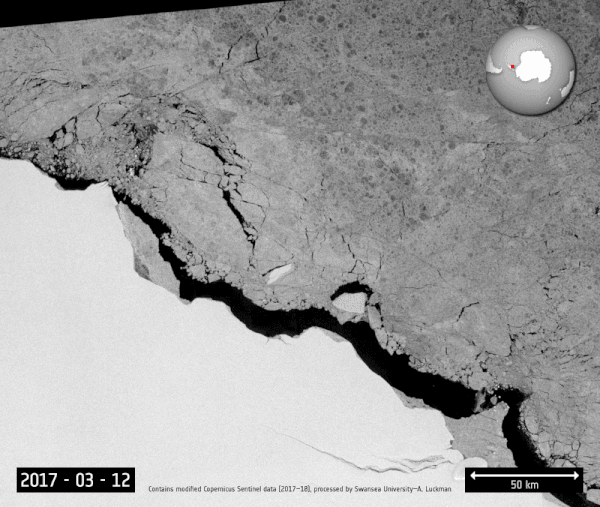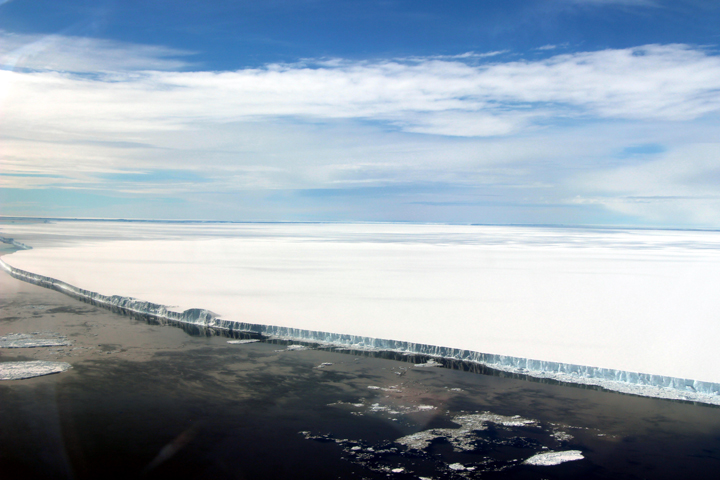

Iceberg A68 took a year to separate from the Larsen C ice shelf in Antarctica. Animated image via ESA’s Copernicus Sentinel-1 mission .
A year ago, ESA reported on the calving of iceberg A68 from the Larsen C ice shelf in Antarctica. It was one of the largest icebergs on record, reducing the size of its ice shelf by about 12 percent. ESA said on September 13, 2018 that this iceberg is finally moving away from Larsen C and drifting out to sea. ESA said:
Sea ice to the east and shallow waters to the north kept this giant berg, named A68, hemmed in. So for more than a year it wafted to and fro, but never left its parent ice shelf’s side. Strong winds blowing from Larsen C have finally given it the push it was waiting for.
In early September 2018, these winds pushed the southern end of the berg out into the Weddell Gyre. This clockwise drift of ocean waters and sea ice flowing north past the Larsen shelf, which can be seen in the animation as a flow from right to left, has rotated A68 out into the Weddell Sea.
Here it is freer to float away and be carried further north into warmer waters.
Adrian Luckman at Swansea University generated the animation above. It uses data from ESA’s Copernicus Sentinel-1 mission, which consists of two satellites. Each carries an advanced radar instrument that can image Earth’s surface through cloud and rain, and during day or night. ESA said:
This is essential for monitoring the polar regions, which are shrouded in darkness during the long winter months.
Is the calving of this large iceberg the result of climate change? There was an interesting article about that at The Conversation last year.

Aerial view of iceberg 68A on November 12, 2017, via Project IceBridge. Read more about this image.
Bottom line: Giant iceberg A68 has, at last, left the Larsen C ice shelf in Antarctica and is due to be carried northward to warmer waters.
from EarthSky https://ift.tt/2D0LSU9


Iceberg A68 took a year to separate from the Larsen C ice shelf in Antarctica. Animated image via ESA’s Copernicus Sentinel-1 mission .
A year ago, ESA reported on the calving of iceberg A68 from the Larsen C ice shelf in Antarctica. It was one of the largest icebergs on record, reducing the size of its ice shelf by about 12 percent. ESA said on September 13, 2018 that this iceberg is finally moving away from Larsen C and drifting out to sea. ESA said:
Sea ice to the east and shallow waters to the north kept this giant berg, named A68, hemmed in. So for more than a year it wafted to and fro, but never left its parent ice shelf’s side. Strong winds blowing from Larsen C have finally given it the push it was waiting for.
In early September 2018, these winds pushed the southern end of the berg out into the Weddell Gyre. This clockwise drift of ocean waters and sea ice flowing north past the Larsen shelf, which can be seen in the animation as a flow from right to left, has rotated A68 out into the Weddell Sea.
Here it is freer to float away and be carried further north into warmer waters.
Adrian Luckman at Swansea University generated the animation above. It uses data from ESA’s Copernicus Sentinel-1 mission, which consists of two satellites. Each carries an advanced radar instrument that can image Earth’s surface through cloud and rain, and during day or night. ESA said:
This is essential for monitoring the polar regions, which are shrouded in darkness during the long winter months.
Is the calving of this large iceberg the result of climate change? There was an interesting article about that at The Conversation last year.

Aerial view of iceberg 68A on November 12, 2017, via Project IceBridge. Read more about this image.
Bottom line: Giant iceberg A68 has, at last, left the Larsen C ice shelf in Antarctica and is due to be carried northward to warmer waters.
from EarthSky https://ift.tt/2D0LSU9

Aucun commentaire:
Enregistrer un commentaire